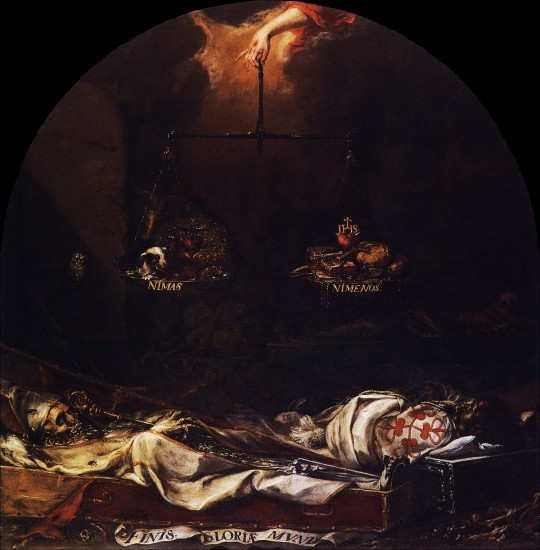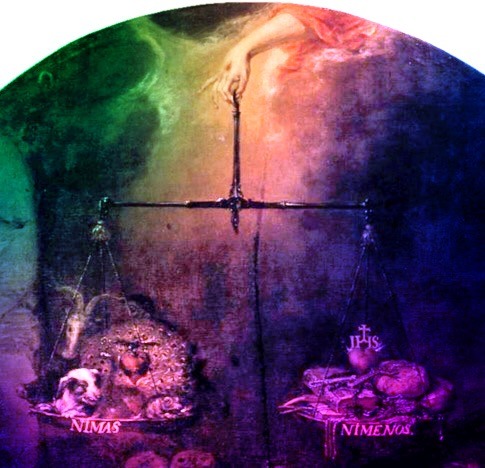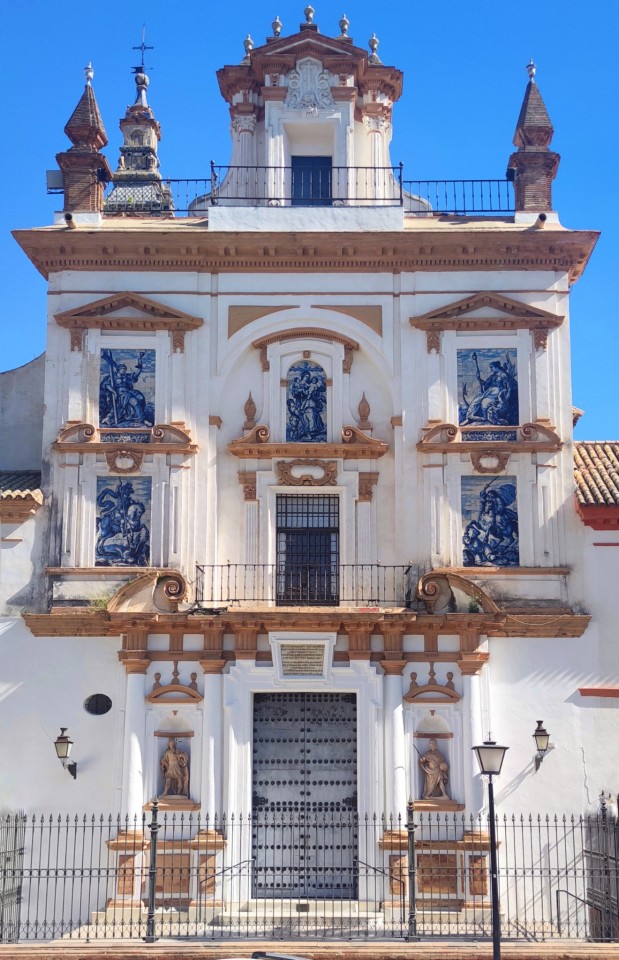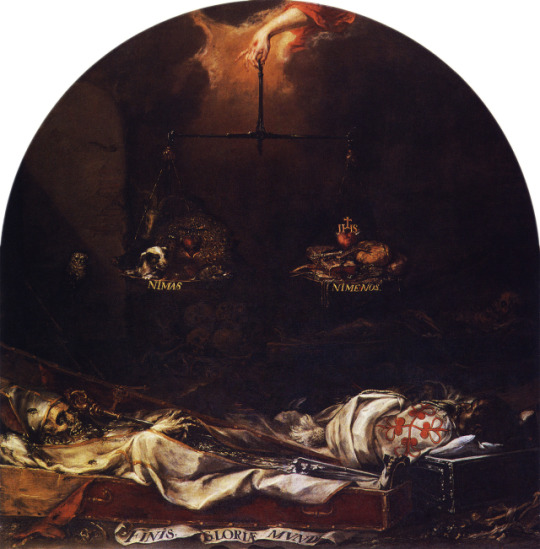#hospital de la caridad de sevilla
Explore tagged Tumblr posts
Text

#art#painting#finis gloriae mundi#hospital de la caridad de sevilla#vanitas#memento mori#spanish#juan de valdés leal#sic transit gloria mvndi
221 notes
·
View notes
Text

Ni más, ni menos
2 notes
·
View notes
Text

Iglesia del Hospital de la Santa Caridad, siglo XVII. Sevilla
Antonio Íñigo, 21 de febrero de 2024
87 notes
·
View notes
Text

🗡️#CuriosidadesdeSevilla
📜#Sevilla en su memoria en este histórico y magnífico recuerdo del pasado de un caballero sevillano... #MiguelMañara... Donde podemos apreciar su ESPADA, junto a una SILLA y una antigua CAJA de CAUDALES en la SALA del CABILDO del Hospital de la Caridad de Sevilla📜
https://sevillaensumemoria.blogspot.com/2023/03/curiosidadesdesevilla-recuerdos-de-un.html?m=1
0 notes
Text
Re-reblogging because I found the story again, and I totally misremembered: Lamarque does not claim to have it from Soult but to have heard the story from somebody else (who remains unnamed) and to only repeat it because... (?)
From "Mémoires et souvenirs du général Maximien Lamarque, volume 1", page 291
As I walked through the Marshal's first salon, I saw again the beautiful painting of the Ascent of the Virgin, a masterpiece that Gros, it is said, places above all the Raphaels, and I remembered a story that was told to me and that I will tell in my turn. It is said that an art lover admiring this painting dared to ask the marshal what he had paid for it: "It only cost me two ropes." - "Two ropes?" - "Yes, two ropes." - And his Excellency told the art enthusiast that two monks involved in a conspiracy were about to be hanged when the community offered to buy them out with this beautiful painting. The marshal allowed himself to be moved, accepted the painting and the two monks were not hanged.
Of course I do not know if Lamarque - or his family and friends - really is at the source of this. Though, frankly, the way this anecdote is inserted into the text does make it look a bit as if somebody wanted to start a rumour.
Nicole Gotteri did accept Soult telling this story as fact, though she assumes it was a rather morbid joke.
-- [Edit: I only now realize that Lamarque seems to refer to a different painting. Or he only misnames it?] --
As to the first story about the acquisition of the "Healing of the Paralytic", the painting surely was not in "some convent", and surely not in one where "Wellington and his redcoated rascals" could have pushed Soult 😋. It belonged to the church of a hospital run by the "Hermandad de la Santa Caridad" in Sevilla. As I don't speak Spanish I do not know if this brotherhood, like all monasteries, was dissolved under French rule or if they were allowed to continue to operate the hospital, and what happened to the church. As a matter of fact, there's rather little information about those two years except for "The French plundered everything!!!!!!111!!!").
Presumably, the paintings once more were taken for the museum, originally, not for Soult's personal collection.
(I do not want to make a guess or anything but I could imagine that during that long journey from Sevilla to Valencia in 1812, when Soult had to give up everything he had worked for because - in his eyes - Joseph was being a bitch, that during that journey a couple of paintings somehow moved from chests that were labelled "José I." to others labelled "Duc de Dalmatie"...)
How Marshal Soult purchased his Picture Gallery
(an alleged anecdote from the 1847 magazine Spirit of the Times; A Chronicle of the Turf, Agriculture, Field Sports, Literature and the Stage (1835-1861); New York Vol. 17, Iss. 9, (Apr 24, 1847): 99 original is a badly scanned pdf, i've attempted to transcribe it as best i can)
"People reproach me with having stolen pictures in Spain, but I bought them, sir - bought them!" "Indeed!" said the listener, with an incredulous elevation of the eyebrow. "Yes, I bought them, sir!" returned Soult. "There, for instance is Murillo, the famous Paralytic —it cost me two monks!" "Two monks!" exclaimed the listener. "Yes, two monks— two as fine, fat, sleek, oily men of God as you ever laid eyes on." "But two monks for a picture!" exclaimed the astonished listener. "Yes, I gave two monks for that picture, sir!" said Soult, "and it was in this way that the bargain was made:—(take some more of the Burgundy.) One evening, after having been pushed rather hard by Wellington and his redcoated rascals, I and a great number of my men took up our quarters in a convent. We made the lazy monks give us a good supper, and plenty of good wine, and then we went off to bed. Next morning when the men were mustered, it was reported to me that some twenty or thirty of my grenadiers had been found with their throats cut—the good monks had just severed their wind-pipes as they slept, and, sure enough, the poor fellows were as dead as slaughtered sheep. Well, I immediately had all the monks drawn up, and said to them: 'You infernal vagabonds, I can't afford to lose my grenadiers in this way, and to convince you of the fact, I intend hanging every one of you.' Such a wail of despair I never heard, followed by piteous supplications for pardon. After frightening them well, I consented so far to pardon them as only to hang the same number of them as they had killed of our men - it was twenty-off, and they were to draw lots. The doomed lot were soon set one side, the ropes knotted around their necks, and my men were just about stringing them up, when two of the victims declared themselves to be the Abbot and his assistant. 'Sorry I can't oblige you, gentlemen, but really (fill your glasses,) I must hang you.' 'Mercy, oh, save us!' 'Can't do it, gentlemen, you really must swing with the rest!' 'Listen,' said the Abbot, 'we have hid away Murillo's Paralytic—take the it as a ransom, and let us go.' I thought this was a far enough bargain, let off the two dignitaries, and up went the rest - thus giving the two monks for the Murillo. And yet people will say that I didn't buy my Spanish gallery.'"
the phrase "fine, fat, sleek, oily men of God" is currently sending me - i thought it might be "only"

but there's not actually enough room for an "n" in there
tagging @josefavomjaaga - this is an anglophone New York magazine in 1847 so it's probably not super accurate but it is very funny
#napoleon's marshals#jean-de-dieu soult#and just because it bugs me#wellington's red-coated rascals pushing soult's army anywhere is particularly funny#because so far i've only found one instance of soult running from wellington#but two of wellington running from soult
20 notes
·
View notes
Text
Testamento del Venerable Siervo de Dios Don Miguel de Mañara
Testamento del Venerable Siervo de Dios Don Miguel de Mañara

Juan Valdés Leal. Finis Gloriae Mundi. 1670-1672. Iglesia de San Jorge. Hospital de La Caridad. Sevilla.
En el nombre de Dios todopoderoso…delante de ciua alta magestad yo su pobre
Esclavo estoi escribiendo este mi testamento y postrera voluntad.
…Yo Don Miguel Mañara, ceniza y polvo, pecador desdichado, que los mas de mis
Malogrados días ofendí a la magestad altíssima de Dios mi padre, cuya…
View On WordPress
0 notes
Photo

Puerta. El Hospital de los Venerables Sacerdotes funcionó sin problemas hasta 1.805 gracias a las limosnas y las facilidades otorgadas por los distintos monarcas. El momento crítico llegó con la ley de Mendizábal que expropió en 1.835 el edificio, debiendo trasladarse los acogidos a una sala cedida por el Hospital de la Caridad. #sevilla #andalucia #instasevilla #fotosevilla #photosevilla #sevillagram #ok_sevilla #instabeautifull #instagood #ig_sevilla_ #total_sevilla #likesevilla #visitsevilla #pic #sevilla_lens #photooftheday #picoftheday #photography #photo #foto #fotografia #instaphoto #instagram #capture #seville #arte #art #historiadesevilla #centro_de_sevilla (en Fundación Focus) https://www.instagram.com/p/Cb-GzmtMHd4/?utm_medium=tumblr
#sevilla#andalucia#instasevilla#fotosevilla#photosevilla#sevillagram#ok_sevilla#instabeautifull#instagood#ig_sevilla_#total_sevilla#likesevilla#visitsevilla#pic#sevilla_lens#photooftheday#picoftheday#photography#photo#foto#fotografia#instaphoto#instagram#capture#seville#arte#art#historiadesevilla#centro_de_sevilla
0 notes
Link
This Wednesday afternoon, the popular television personality Juan Joya Borja, better known as "El Risitas", died at the Virgen del Rocío Hospital in Seville. In September 2020 "El Risitas" was admitted to the Hospital de la Caridad in Seville, where he had been living since then. At 64 years of age and after suffering the amputation of a leg as a result of an illness, "El Risitas" requested admission to the institution that was promoted by the Venerable Miguel Mañara and managed by the brotherhood of the Holy Charity of Seville.
F
0 notes
Photo

El regreso del hijo pródigo, 1667/1670, de Bartolomé Esteban Murillo (Sevilla, bautizado el 1 de enero de 1618 – 3 de abril de 1682), pintor barroco español. Óleo sobre lienzo, en general: 236.3 x 261 cm, enmarcado: 262.9 x 286.4 x 8.6 cm. Donación de la Fundación Avalon, National Gallery of Art.
VISIÓN GENERAL
El gran talento de Murillo para la pintura dramática es evidente en esta representación monumental de la parábola familiar del hijo pródigo, una alegoría del arrepentimiento y el perdón divino. Con jugadores y accesorios colocados efectivamente para subrayar el drama, es una reminiscencia de una pieza de teatro bien puesta en escena.
El artista seleccionó los elementos esenciales del clímax de la historia: el hijo penitente recibió la bienvenida de su padre indulgente; las ricas vestimentas y anillos que significan la restauración del hijo errante a su antigua posición en la familia; y el ternero gordo fue llevado a la matanza para el banquete de celebración. La agrupación piramidal central más grande que la vida de padre e hijo domina la imagen, mientras que el color más rico está reservado para el sirviente que lleva las nuevas prendas. Murillo pudo haber elegido enfatizar ese aspecto de la parábola, simbólico de la caridad, debido a la naturaleza de la comisión. El regreso del hijo pródigo fue uno de los ocho grandes lienzos pintados para la Iglesia del Hospital de San Jorge en Sevilla, un hospicio para personas sin hogar y hambrientos.
El modelo de Murillo era la vida a su alrededor; parte del atractivo de este lienzo radica en sus toques humanos: el realismo de los pies sucios del hijo pródigo, el cachorro saltando para saludar a su amo, y tal vez, sobre todo, la ingenua sonrisa del pequeño erizo que lidera la pantorrilla.
Información del museo.
0 notes
Text

🧑🎨#Efeméride: 27/01/1945.
En un día como hoy FALLECE el artista sevillano don JOSÉ LAFITA DÍAZ, el cual, estuvo interesado principalmente por la escultura y el diseño.
Entre su obra más importantes podemos destacar la fuente que adorna la Plaza de la Virgen de los Reyes, junto a la Giralda 1929. La estatua del Almirante Bonifaz que figura en el pedestal del monumento a nuestro Santo Fernando III de Castilla, en la Plaza Nueva (1924). La gran y bellísima estatua del Monumento al Sagrado Corazón de San Juan de Aznalfarache (1944). El busto de don Miguel Mañara que se encuentra ubicado en los jardines del Hospital de la Caridad de Sevilla (1928) y la fuente, que hubo hasta no hace mucho, en el Patio de Banderas (1928).
Como curiosidad, cabe mencionar, que fue un gran aficionado al deporte, llegando a formar parte, en el año 1905, de los fundadores y jugadores del Sevilla Fútbol Club, para cuyo equipo diseñó su primer escudo...
📸 1948.
https://sevillaensumemoria.blogspot.com/2023/01/efemeride-27011945-fallece-el-artista.html?m=1
1 note
·
View note
Text
as an occupying force I don't think soult's dealings were completely on an equal level
Absolutely! Sorry if I came across as if I wanted to exonerate the looting of art. I merely wanted to point out that things were a little more complicated and a little less obvious than the word "looting" seems to imply.
As to the Hospital de la Caridad - or rather its church as I understand the paintings Soult took came from there - it would be interesting what happened to it after the French occupation of Sevilla. Was the church closed? All male religious orders were dissolved by the new king Joseph, and their art taken to the Alcazar. Were these paintings among them, and what happened to them then?
There may be an additional layer to this question that I'm not qualified to talk about: that of national historiography. The "Guerra de la Independencia" seems to have a similar meaning as a national myth for Spain as the "Great patriotic war" had for Russia or the "Befreiungskriege" for Prussia/Germany. There is no place for nuances in myths. From the little I have read, Spanish historiography has treated the pro-French party in 19th century Spain quite like Prussian history the pro-French party in Germany: either it was kept under the rug, or they were labelled as traitors. Yet by all accounts there must have been a huge pro-French party in Andalusia. After all, the Andalusians had celebrated Joseph's entrance into the city. His journey through the province had been triumphal.
The people who may have "gifted" (for reasons, of course!) Soult with some of his paintings were the same people who later had to leave Spain and go into exile in France. Their own countrymen demonized them. And if they wanted to return, their only option was to claim they had been forced to act like they had.
Lots of layers.

Why did the painting end up being named after him just because he’s the one who grabbed it
Why does it sound like Soult is the one getting conceived???????
just going to tag @josefavomjaaga to subject my soultposting to someone
26 notes
·
View notes
Text
El testamento de Miguel Mañana
El testamento de Miguel Mañana

Lápida sepulcral de Miguel Mañara. Iglesia de San Jorge. Hospital de la Caridad. Sevilla.
En el nombre de Dios todopoderoso… delante de cuia alta magestad yo su pobre
esclavo estoi escribiendo este mi testamento y postrera voluntad.
… Yo Don Miguel Mañara, ceniza y polvo, pecador desdichado, que los mas de mis
malogrados días ofendí a la magestad altíssima de Dios mi padre, cuya criatura y
escl…
View On WordPress
0 notes
Photo

In Ictu Oculi (1670-72), Juan de Valdés Leal. Hospital de la Caridad, Sevilla
5 notes
·
View notes
Photo

Portada. Hospital de la Caridad de Carmona: Del Hospital apenas queda ya nada. Tan solo se conserva la capilla y la Sala Capitular, actualmente bautizada como de la Hermandad de la Columna. #carmona #turismocarmonaoficial #sevilla #andalucia #instasevilla #fotosevilla #photosevilla #sevillagram #ok_sevilla #instabeautifull #sevillamaravilla #sevillatieneuncolorespecial #total_sevilla #likesevilla #visitsevilla #patrimoniosevilla #sevilla_lens #photooftheday #fotodeldia #photography #photo #foto #fotografia #instaphoto #instagram #callejeandoporsevilla #seville #arte #art #historiadesevilla (en Carmona) https://www.instagram.com/p/CVXxYJEMf_M/?utm_medium=tumblr
#carmona#turismocarmonaoficial#sevilla#andalucia#instasevilla#fotosevilla#photosevilla#sevillagram#ok_sevilla#instabeautifull#sevillamaravilla#sevillatieneuncolorespecial#total_sevilla#likesevilla#visitsevilla#patrimoniosevilla#sevilla_lens#photooftheday#fotodeldia#photography#photo#foto#fotografia#instaphoto#instagram#callejeandoporsevilla#seville#arte#art#historiadesevilla
0 notes
Text
Horarios y recorrido del Traslado de María Santísima de Guadalupe de la Hdad de Las Aguas de Sevilla a la Capilla de San Jorge
Horarios y recorrido del Traslado de María Santísima de Guadalupe de la Hdad de Las Aguas de Sevilla a la Capilla de San Jorge
El Domingo 12 de Diciembre, festividad de María Santísima de Guadalupe, la Virgen saldrá a las 9:15 horas desde la capilla para trasladarse hasta el Hospital de la Caridad, donde visitará a los residentes de dicho hospital. Una vez en la Iglesia de San Jorge tendrá lugar a las 11:00 horas la Función Solemne en honor a María Santísima de Guadalupe. La función será presidida por S.E.R.D José Ángel…

View On WordPress
0 notes



